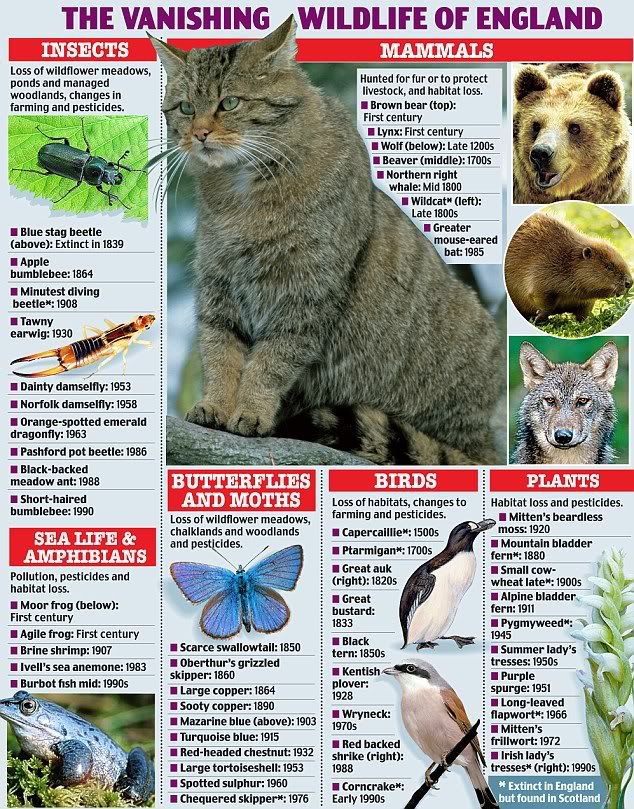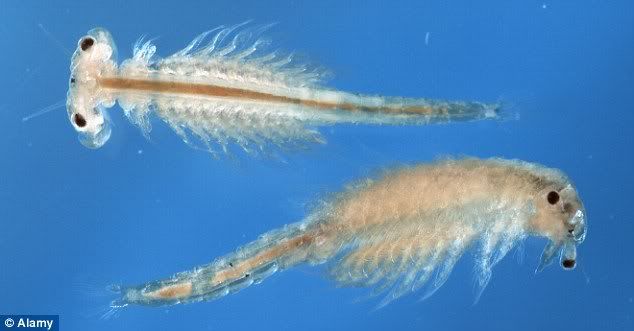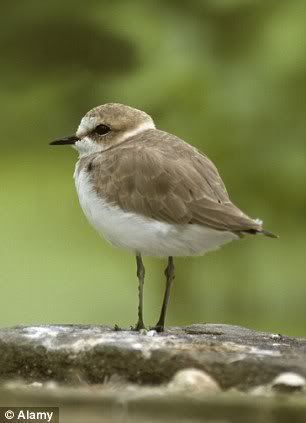



Under water: Brine shrimp became extinct in 1907, largely as a result of pollution and habitat loss.Under threat: The Kentish plover became extinct in 1928 due to loss of habitat and changes to farming and peticides
It is being called the sixth great extinction.
Nearly 500 species of plant and animal native to England have been wiped out in the past 2,000 years - with most vanishing in the previous two centuries alone.
The roll-call, detailed in a shocking report, includes mammals such as the wildcat and northern right whale, birds such as the great auk and red-backed shrike, and species of butterflies, dragonflies and beetles.
Some creatures, including the bear, were hunted to extinction after the Romans invaded, while others, such as the short-haired bumblebee, were killed off by modern farming techniques during the 1990s.
A handful of the extinct species were unique to England and can never be brought back, the report by Natural England, which advises the Government on environmental issues, warns.
Its audit - the first- ever of native wildlife - also found that a quarter of English species are declining rapidly or threatened.
Dr Tom Tew, Natural England's chief scientist, said the Lost Life report - drawing on records going back two millennia - presented a stark message about England's wildlife.The message is clear: We are losing species at an alarming rate and many are seriously threatened,' he said.
Species once described as 'common', such as common sparrows, common frogs and common toads, were now barely seen, he added.
'You don't need to be an "ologist" to understand that when we lose our wildlife we lose something precious that reduces our quality of life,' he said.
'Every species has a role, like the rivets in an aeroplane or bricks in a dam, and the overall structure of the environment is weakened when you lose a species.'
Fossil experts believe that the world has gone through five mass extinctions in its history - caused by events including natural climate change, wobbles in the Earth's orbit and collisions with asteroids.
And, according to some conservationists, the scale of extinction in the past 200 years means we are living through a sixth. The report found evidence that 492 species have been lost in England - with most killed off since 1800.
It includes 24 per cent of all butterflies, 22 per cent of amphibians, 15 per cent of dolphins and whales, and 12 per cent of land mammals.
Some - such as the great auk, often nicknamed the 'original penguin', and Ivell's sea anemone - are no longer alive anywhere in the world.
The study also reveals that 943 English species, including the leatherback turtle and pine martin - are under threat.
And it warns that while a few 'big, hairy and scary' animals such as bears and wolves were hunted to extinction, most of those disappearing are the victims of intensive farming, pollution and pesticides.
Over the last few decades, England has lost countless wildflower meadows, ponds, chalklands and peatlands as farmers have changed how they sow crops - depriving birds and insects of winter food.
The loss of woodlands and the neglect of forests and woods has also hit many species, as has the introduction of alien wildlife such as mink and grey squirrels.
Even where species have not become extinct at a national level, many have disappeared from parts of the country, leaving populations fragmented and more at risk from threats including a changing climate.
On average, every English county has lost at least one species of plant or animal every two years for the past century.
But the study isn't all gloom and doom. It also found red kites, large blue butterflies and pool frogs have all been successfully re-introduced to the countryside in the past few decades.
And action to improve habitat for species such as bitterns and sand lizards have also helped stem and reverse declines in those animals.
Natural England has now called for a campaign to halt the decline of wildlife and to protect environmental sites from planners.
It also wants a change from protecting individual species to 'restoring the health of ecosystems across entire landscapes'.





